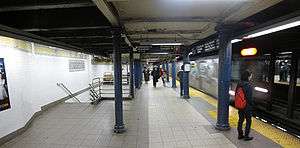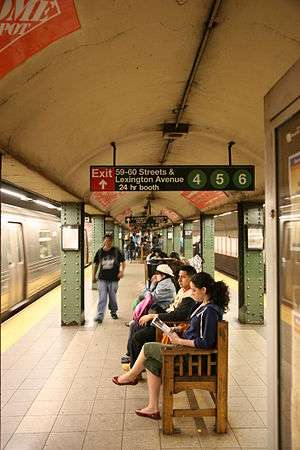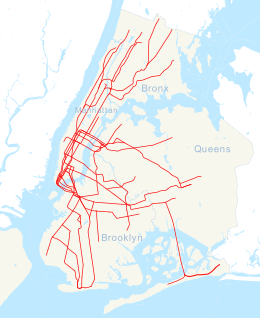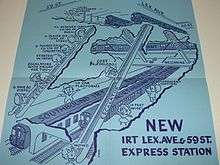Lexington Avenue/59th Street station
Lexington Avenue/59th Street is a New York City Subway station complex shared by the IRT Lexington Avenue Line and the BMT Broadway Line. It is located at Lexington Avenue between 59th and 60th Streets, on the border of Midtown and the Upper East Side of Manhattan. The station complex is the fourteenth-busiest in the system, with over 21 million passengers in 2016.[5]
Lexington Avenue/59 Street | |||||||||||||
|---|---|---|---|---|---|---|---|---|---|---|---|---|---|
Street stair by southeast corner of 59th Street and Lexington Avenue (The Q train served this station during the W's discontinuation from 2010-2016) | |||||||||||||
| Station statistics | |||||||||||||
| Address | East 59th Street & Lexington Avenue New York, NY 10022 | ||||||||||||
| Borough | Manhattan | ||||||||||||
| Locale | Midtown Manhattan, Upper East Side | ||||||||||||
| Coordinates | 40.762471°N 73.9679°W | ||||||||||||
| Division | A (IRT), B (BMT) | ||||||||||||
| Line | BMT Broadway Line IRT Lexington Avenue Line | ||||||||||||
| Services | 4 5 6 N R W | ||||||||||||
| System transfers | With MetroCard only: F and <F> N Q R | ||||||||||||
| Transit connections | |||||||||||||
| Structure | Underground | ||||||||||||
| Levels | 3 | ||||||||||||
| Other information | |||||||||||||
| Opened | July 1, 1948[1] | ||||||||||||
| Station code | 613[2] | ||||||||||||
| Accessible | not ADA-accessible; accessibility planned | ||||||||||||
| Wireless service | |||||||||||||
| Traffic | |||||||||||||
| Passengers (2019) | 16,760,813[4] | ||||||||||||
| Rank | 15 out of 424[4] | ||||||||||||
| |||||||||||||
| |||||||||||||
| |||||||||||||
Signed as 59th Street–Lexington Avenue, the complex is served by the:
- 4, 6, and N trains at all times
- W train on weekdays
- 5 and R trains at all times except late nights
- <6> express train during weekdays in peak direction
A free out-of-system MetroCard transfer is available to the 63rd Street Lines (F and Q trains, as well as rush-hour N and R, and evening and weekend M trains) by exiting the station and walking to the Lexington Avenue–63rd Street station.
Station layout
| G | Street level | Exits/entrances, MetroCard connection to |
| B1 | Third Avenue mezzanine | Fare control, MetroCard machines, to Broadway Line platforms |
| Fare control, MetroCard machines, to northbound platforms and Bloomingdale's | ||
| Side platform | ||
| Northbound local | ← ← | |
| Southbound local | | |
| Side platform | ||
| Fare control, MetroCard machines, to southbound platforms | ||
| B2 | Crossunder | Crossunder between local platforms |
| Southbound | ← ← ← | |
| Island platform | ||
| Northbound | | |
| B3 | Mezzanine | Transfer between platforms |
| B4 | Side platform | |
| Northbound express | ← ← | |
| Southbound express | | |
| Side platform | ||
The center level is located at the 60th Street/Lexington Avenue end. Installed in conjunction with the 1962 opening of the lower level IRT express platforms, it allows transfer between all routes. There are three staircases up to the BMT platform, two down to each of the lower level IRT express platforms, and one staircase and escalator up to the IRT local platforms on the upper level.
Artwork
The mezzanine between the IRT express platforms and the BMT platform has a large-scale mosaic mural entitled Blooming (1996), by Elizabeth Murray. It covers all four walls of the mezzanine area. It takes its name from the nearby Bloomingdale's department store.[6] The mosaic features larger versions of the coffee cups and slippers found on the platform walls, with the text: "In dreams begin responsibilities" and "Conduct your blooming in the noise and whip of the whirlwind". The text floats from the coffee cups and are excerpted from poetry by Delmore Schwartz and Gwendolyn Brooks. Additional, mini shoe mosaics can be found on the IRT express platforms.
This is one of two murals Murray made for MTA Arts & Design; the other, Stream, can be found at Court Square/23rd Street.
Entrances and exits
The complex has a total of 11 staircase entrances.[7]
| Exit location | Exit type | Number of exits | Platforms primarily served |
|---|---|---|---|
| NW corner of Lexington Avenue and 59th Street | Staircase | 1 | Lexington Avenue Line (southbound) |
| SE corner of Lexington Avenue and 59th Street | Staircase | 1 | Lexington Avenue Line (northbound) |
| Direct passageway to Bloomingdale's |
1 | ||
| SW corner of Lexington Avenue and 59th Street | Staircase | 1 | Lexington Avenue Line (southbound) |
| NE corner of Lexington Avenue and 60th Street | Staircase | 1 | Broadway Line Lexington Avenue Line (northbound) |
| NW corner of Lexington Avenue and 60th Street | Staircase | 1 | Broadway Line Lexington Avenue Line (southbound) |
| SE corner of Lexington Avenue and 60th Street | Staircase | 1 | Broadway Line Lexington Avenue Line (northbound) |
| SW corner of Lexington Avenue and 60th Street | Staircase | 1 | Broadway Line Lexington Avenue Line (southbound) |
| NE corner of Third Avenue and 60th Street | Staircase | 1 | Broadway Line |
| NW corner of Third Avenue and 60th Street | Staircase | 1 | Broadway Line |
| SE corner of Third Avenue and 60th Street | Staircase | 1 | Broadway Line |
| SW corner of Third Avenue and 60th Street | Staircase | 1 | Broadway Line |
IRT Lexington Avenue Line platforms
59 Street | |||||||||||||
|---|---|---|---|---|---|---|---|---|---|---|---|---|---|
 An uptown 6 train of R142A cars enters on the local platform | |||||||||||||
| Station statistics | |||||||||||||
| Division | A (IRT) | ||||||||||||
| Line | IRT Lexington Avenue Line | ||||||||||||
| Services | 4 5 6 | ||||||||||||
| Levels | 2 | ||||||||||||
| Platforms | 4 side platforms (2 on each level) | ||||||||||||
| Tracks | 4 (2 on each level) | ||||||||||||
| Other information | |||||||||||||
| Opened | July 17, 1918[8] (upper level) November 15, 1962 (lower level)[9] | ||||||||||||
| Station code | 400[2] | ||||||||||||
| Accessible | |||||||||||||
| Wireless service | |||||||||||||
| Opposite-direction transfer available | Yes | ||||||||||||
| Station succession | |||||||||||||
| Next north | 86th Street (express): 4 68th Street–Hunter College (local): 4 | ||||||||||||
| Next south | 51st Street (local): 4 Grand Central–42nd Street (express): 4 | ||||||||||||
| |||||||||||||
59th Street on the IRT Lexington Avenue Line is an express station. It has two stacked levels, each of which has two tracks and two side platforms. The upper level is used by local trains, and the lower level is used by express trains. The levels are separated by the BMT Broadway Line's platform directly underneath the local platforms and a mezzanine between the BMT platform and the express level. Long escalators connect the local and express platforms directly.

The station used to have all green tile which has been covered up except for one "59th Street" sign near the south end of the northbound platform. There are whimsical stylized mosaics of coffee cups and slippers in varied colors at random spacing near the stairways to the Broadway and IRT local trains. This station was renovated in conjunction with the construction of the Bloomberg Tower at 59th Street and Lexington Avenue. Although a new entrance was constructed within the building, it has remained closed due to fears of icicle formation on a railing that is part of the building's design, directly above the street entrance. A legal battle between the city and the building's management over who is responsible for modifying the design has caused the entrance to be temporarily closed between 2003 and 2006.
There is a direct exit to Bloomingdale's from the uptown local platform's fare control (this exit was used in the 2008 film Cloverfield). The underpass near the south end of the station was originally the northbound platform for the extension of the BMT Broadway Line to Queens. That line had been planned as two separate, one-track tunnels, one each under 59th and 60th Streets. Later on, it was decided to alter this layout in favor of a single two-track tunnel under 60th Street. The semi-completed platform under 59th Street was then converted to an underpass between the north and southbound platforms of the Lexington Avenue Line local tracks.
On the upper level, north of the station, there is a storage/lay up track between the two tracks. It ends at a bumper block at its north end. It merges with the two local tracks on its southern end.
In 2019, the Metropolitan Transportation Authority announced that the station would become ADA-accessible as part of the agency's 2020–2024 Capital Program.[10]
Addition of express platforms
The station originally served local trains only.[11] On November 4, 1954, the New York City Transit Authority approved plans to convert 59th Street into an express station. The project was proposed by the executive director of the NYCTA, Sidney Bingham, to improve connections between the Lexington Avenue Line and the Broadway Line. Construction was expected to take two years and cost $5 million. The new express stop was expected to reduce transfer congestion at Grand Central–42nd Street.[12] Even before the express platforms were added, this station was the busiest on the line.[13]
Construction for the express station began on August 10, 1959. Along with the new express platforms, a new mezzanine was built above it to connect it to the local station, and the Broadway Line station. Two high speed escalators were added to connect the local and express platforms. Two additional high speed escalators were built to connect the local platforms with the new mezzanine. The express station opened three months earlier than originally planned. As part of the plan, the local platforms were extended to accommodate 10-car trains. In addition, new entrances and booths were added to the 59th Street ends of the northbound and southbound sides. The whole cost of the project was $6.5 million.[9] Work on the express station at 59th Street, required express trains to run local during late nights.[14] The express platforms were opened on November 15, 1962.[9]
BMT Broadway Line platform
Lexington Avenue−59 Street | |||||||||||
|---|---|---|---|---|---|---|---|---|---|---|---|
 Platform view | |||||||||||
| Station statistics | |||||||||||
| Division | B (BMT) | ||||||||||
| Line | BMT Broadway Line | ||||||||||
| Services | N R W | ||||||||||
| Platforms | 1 island platform | ||||||||||
| Tracks | 2 | ||||||||||
| Other information | |||||||||||
| Opened | September 1, 1919[15] | ||||||||||
| Station code | 008[2] | ||||||||||
| Accessible | not ADA-accessible; accessibility planned | ||||||||||
| Accessibility | Same-platform wheelchair transfer available | ||||||||||
| Wireless service | |||||||||||
| Opposite-direction transfer available | Yes | ||||||||||
| Station succession | |||||||||||
| Next east | Queensboro Plaza (Astoria): N Queens Plaza (Queens Boulevard): R | ||||||||||
| Next west | Fifth Avenue–59th Street: N | ||||||||||
| |||||||||||
Lexington Avenue−59th Street on the BMT Broadway Line has two tracks and one island platform, and two mezzanines. The Lexington Avenue mezzanine has two staircases to each of the IRT local platforms, an escalator to the downtown platform, and three staircases down to the center level. The Third Avenue side was constructed in the late 1960s, with the same red tile that was used during renovation of Bowling Green in 1978. It has up and down escalators and an adjoining staircase, and is open part-time only, with four street staircases on Third Avenue. The new entrance is a result of the platform extension along the same side during the 1960s.
The distinctive "Lex" mosaics were preserved during the renovation, by installing pre-arranged blocks along the station wall that cup the Lexington Avenue Line above it. The wall tiles have the red "Lex" evenly spaced out, similar to the IND style, with blue background, green borders, and white lettering. In 2002, the station received a major overhaul. It received a state of repairs with the original late 1910s tiling being restored. The MTA repaired the staircases, re-tiled the walls, added new tiling on the floors, upgraded the station's lights and the public address system, and installed ADA yellow safety threads along the platform edge, new signs, and new trackbeds in both directions. Despite this, the project did not make the station ADA-accessible. In 2019, the MTA announced that the station would become ADA-accessible as part of the agency's 2020–2024 Capital Program.[10]
Despite its name, the station is located on Lexington Avenue and 60th Street, one block north of 59th Street. Originally, the Broadway subway was to run to Queens over the Queensboro Bridge. Because the side streets are so narrow, the Queens-bound track was to run under 59th Street and the downtown-bound track under 60th Street.[16] The Broadway subway plan was changed in 1915 to route both tracks into 60th Street and to cross the East River by a tunnel just north of the Queensboro Bridge. The 59th Street crossing was now useless, and at 60th Street, the subway would have to be at a lower grade on its way to the 60th Street Tunnel. The 59th Street crossing was converted into a pedestrian underpass for the IRT station, and is still in use for that purpose; its floor level is that of the never-completed BMT station. The 60th Street crossing was mostly destroyed when the existing station was built at a lower grade. A door in the southern wall across from the platform opens into a remaining unused space,[17] and suggests the platform level of the original grade, which is the same as the 59th Street underpass.
References
- New York Times, Transfer Points Under Higher Fare, June 30, 1948, page 19
- "Station Developers' Information". Metropolitan Transportation Authority. Retrieved June 13, 2017.
- "NYC Subway Wireless – Active Stations". Transit Wireless Wifi. Retrieved November 13, 2019.
- "Facts and Figures: Annual Subway Ridership 2014–2019". Metropolitan Transportation Authority. 2020. Retrieved May 26, 2020.
- http://web.mta.info/mta/aft/permanentart/permart.html?agency=nyct&line=R&artist=1&station=5
- "MTA Neighborhood Maps: Upper East Side (Yorkville, Central Park, Lenox Hill)" (PDF). mta.info. Metropolitan Transportation Authority. 2016. Retrieved December 30, 2016.
- "Lexington Av. Line to be Opened Today" (PDF). The New York Times. July 17, 1918. p. 13. ISSN 0362-4331. Retrieved April 21, 2020.
- "New 59th Street Express Station brochure". www.thejoekorner.com. New York City Transit Authority. November 15, 1962. Retrieved January 25, 2016.
- "Press Release - MTA Headquarters - MTA Announces 20 Additional Subway Stations to Receive Accessibility Improvements Under Proposed 2020-2024 Capital Plan". MTA. December 19, 2019. Retrieved December 24, 2019.
- "East Side Subway to Get Express Stop at 59th St.", New York Times; April 8, 1959; page 1
- Ingalls, Leonard (November 5, 1954). "East 59th Street I. R. T. Station To Be Express Stop in 2 Years; EAST 59TH ST. GETS I.R.T. EXPRESS STOP". The New York Times. ISSN 0362-4331. Retrieved March 29, 2018.
-
- "IRT Will Open Express Station at Lexington and 59th Thursday", New York Times; November 9, 1962; page 37
- "IRT Express Stop Opens at 59th St.", New York Times; November 16, 1962; page 22
- "IRT WILL CURTAIL EAST SIDE SERVICE". The New York Times. February 29, 1960. ISSN 0362-4331. Retrieved September 4, 2016.
- New York Times, Subway to Open Two New Stations, August 31, 1919, page 25
- Lexington Ave (BMT) unfinished platforms
- "Archived copy". Archived from the original on March 5, 2016. Retrieved November 30, 2016.CS1 maint: archived copy as title (link)
External links
| Wikimedia Commons has media related to Lexington Avenue/59th Street (New York City Subway). |
- nycsubway.org – IRT East Side Line: 59th Street
- nycsubway.org – BMT Broadway Subway: Lexington Avenue/59th Street
- nycsubway.org — Blooming Artwork by Elizabeth Murray (1996)
- Station Reporter — 59th Street and Lexington Avenue Complex
- MTA's Arts For Transit — 59 Street/Lexington Avenue — 59th Street
Google Maps Street View:






